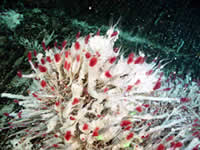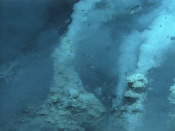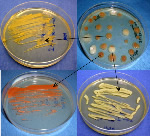
Ecosystems
Hydrothermal vents in the deep ocean host unique ecosystems where chemical energy nurtures life instead of sunlight. EOI works with international collaborators in the fields of biology, microbiology, pharmacology, and ecology to understand the relationships between hydrothermal output, volcanic activity, and chemosynthetic ecosystems in the deep sea.
Ocean Acidification
 |
Ocean acidification is a critical global issue with serious ecological consequences. To mitigate and predict its effects requires a range of approaches. Underwater volcanoes produce local sites of chronically lowered pH due to magmatic gas venting, and provide important natural laboratories to study the impact of ocean acidification on individual species and complex ecosystems. Read more about this research at EOI's Ocean Acidification site. |
Pharmacology

|
The Earth-Oceans Interactions (EOI) Program is contributing to drug discovery research in collaboration with the Oregon State University (OSU) College of Pharmacy by identifying functional new natural products from interactions between hydrothermal vent-derived microorganisms and bacterial pathogens. Very little is known about the natural products produced by deep-sea vent organisms, and thus they represent an untapped resource with great potential in the search for new drugs from the sea. Visit EOI's Pharmacology site for more information. |
Research Highlights:
Mussels at a submarine volcano survive for decades despite the presence of extremely acidic waters due to high CO2 output, providing a glimpse into an ecosystem’s response to ocean acidification, as is expected from the rising levels of atmospheric carbon dioxide.
Nature Geosciences
National Public Radio story on the unique microbes at Axial Seamount, discovered during EOI Program expeditions and work by our ecosystem collaborators:
New Discoveries in Deep-Sea Biodiversity
Visit a gallery of the species of deep-sea animals found at Axial Seamount. Most of these species are only found at hydrothermal vents. This gallery is part of our NeMO web site focused on research at Axial Seamount.
Gallery of vent animals
